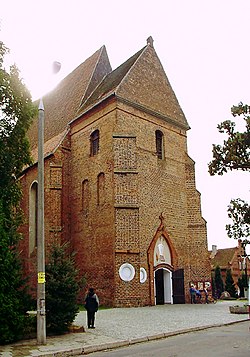Kobylin([kɔˈbɨlʲin]) is a town inKrotoszyn County,Greater Poland Voivodeship,Poland,with 3,130 inhabitants (2010).[1]
Kobylin | |
|---|---|
 GothicSaint Stanislaus Kostka church in Kobylin | |
| Coordinates:51°42′N17°14′E/ 51.700°N 17.233°E | |
| Country | |
| Voivodeship | Greater Poland |
| County | Krotoszyn |
| Gmina | Kobylin |
| Town rights | before 1303 |
| Area | |
• Total | 4.92 km2(1.90 sq mi) |
| Population (2010)[1] | |
• Total | 3,130 |
| • Density | 640/km2(1,600/sq mi) |
| Time zone | UTC+1(CET) |
| • Summer (DST) | UTC+2(CEST) |
| Postal code | 63-740 |
| Climate | Cfb |
| Website | http:// kobylin.pl |
History
editIn theEarly Middle Agesit was a market settlement,[2]which became part of the emerging Polish state in the 10th century, as part of theGreater Polandregion. It was mentioned in documents from 1289.[3]Kobylin was grantedtown rightsbefore 1303.[2]Initially, it was calledWenecja.[4]It was aprivate townadministratively located in the Pyzdry County in theKalisz Voivodeshipin theGreater Poland Provinceof the Kingdom of Poland.[5]In 1456 a school was established at the Bernardine monastery.[4]Its graduates usually enrolled to theUniversity of Kraków,Poland's oldest and leading university. Among them were professors of the University of Kraków: Maciej of Kobylin, who was a philosopher and one of the teachers ofNicolaus Copernicus,Piotr of Kobylin, author of the first known Polishtextbook,andAndrzej Glaber,translator of the firstanatomicalbook published in thePolish language.[2][4]Famousfairswere held in Kobylin during the reign of KingSigismund II Augustus.[6]During theThirty Years' War,Protestant refugees fromSilesiasettled in the town.[2]One of the greatestPolish BaroquepoetsSamuel Twardowskiwas buried in the Bernardine church.[6]The town was plundered by theSwedesduring theDelugeandGreat Northern War,and by theRussiansduring theSeven Years' War.[6]
After theSecond Partition of Poland,in 1793 it was annexed byPrussia.Following the successfulGreater Poland uprising of 1806,it was regained by Poles and included in the short-livedDuchy of Warsaw,in 1815 it was re-annexed by Prussia.[2]Four annual fairs were held in Kobylin in the mid-19th century.[6]Local Poles took part in theGreater Poland uprising (1918–19),[4]after which Kobylin was integrated with Poland, shortly after it regained independence.
DuringWorld War IIKobylin was underGerman occupationfrom September 1939 to January 1945. The GermansexpelledthePolishpopulation to theGeneral Governmentin the more eastern part of occupied Poland or imprisoned inNazi concentration camps.[3]In November 1939, the Germans murdered six Poles fromBiadkiin the nearby forest.[7]The Germans also set up a camp for children taken fromorphanagesfromGreater PolandandPomerania(seeKidnapping of children by Nazi Germany).[3]ThePolish resistancewas active in Kobylin. TheGrey Ranksprinted and distributedPolish underground pressthere.[8]
Demographics
edit
|
| |||||||||||||||||||||||||||||||||||||||||||||
| Source:[6][9][10][1] | ||||||||||||||||||||||||||||||||||||||||||||||
References
edit- ^abcStan i struktura ludności oraz ruch naturalny w przekroju terytorialnym w 2010 r.(PDF)(in Polish). Warszawa: Główny Urząd Statystyczny. 2011. p. 104. Archived fromthe original(PDF)on 13 November 2011.
- ^abcde"Kobylin - Dzieje Miast".Region Wielkopolska(in Polish).Retrieved28 February2020.
- ^abc"Kobylin".Encyklopedia PWN(in Polish).Retrieved28 February2020.
- ^abcd"Historia".Portal - UG Kobylin(in Polish).Retrieved28 February2020.
- ^Atlas historyczny Polski. Wielkopolska w drugiej połowie XVI wieku. Część I. Mapy, plany(in Polish). Warszawa: Instytut HistoriiPolskiej Akademii Nauk.2017. p. 1b.
- ^abcdePlater, Leon (1846).Opisanie historyczno-statystyczne Wielkiego Księztwa Poznańskiego(in Polish). Lipsk: Księgarnia Zagraniczna. p. 241.
- ^Wardzyńska, Maria (2009).Był rok 1939. Operacja niemieckiej policji bezpieczeństwa w Polsce. Intelligenzaktion(in Polish). Warszawa:IPN.p. 275.
- ^Encyklopedia konspiracji Wielkopolskiej 1939–1945(in Polish). Poznań: Instytut Zachodni. 1998. pp. 408–409.ISBN83-85003-97-5.
- ^Wiadomości Statystyczne Głównego Urzędu Statystycznego(in Polish). Vol. X. Warszawa: Główny Urząd Statystyczny. 1932. p. 201.
- ^Dokumentacja Geograficzna(in Polish). Vol. 3/4. Warszawa: Instytut GeografiiPolskiej Akademii Nauk.1967. p. 21.

